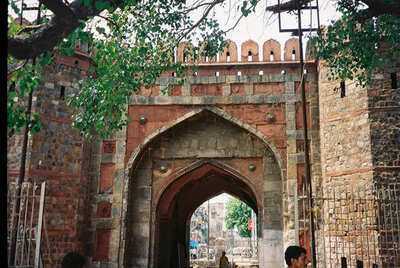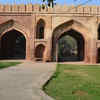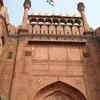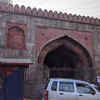
Shah Jahan's Delhi, Shahjahanabad, featured several significant gates, each with a unique history. The Kashmiri Gate, named for its northward direction towards Kashmir, became a focal point during the 1857 rebellion, bearing scars of the conflict. The Ajmeri Gate, leading towards Ajmer, remains a busy thoroughfare, connecting old Delhi to newer parts of the city. Though Lahore gate is a prominent gate in Lahore, Pakistan, it is not a gate in Delhi built by Shahjahan. The gates of Delhi, including Kashmiri and Ajmeri, were vital for defense and commerce, controlling access to the walled city. These structures represent Mughal architectural ingenuity and urban planning, serving as historical markers of Delhi's rich past, witnessing centuries of change and conflict.
Kashmere Gate:

This gate holds a significant place in Delhi's history, marked by its Mughal origins and its crucial role in the 1857 Indian Rebellion. Here's a concise overview:
Mughal Origins:It was one of the primary gates of Shahjahanabad, the walled city built by Emperor Shah Jahan in the mid-17th century.
Its name derives from its position on the road leading towards Kashmir.
1857 Rebellion:Kashmere Gate became a focal point during the 1857 Indian Rebellion.
It witnessed intense fighting between British forces and Indian rebels.
The gate bears visible signs of the conflict, particularly damage from cannon fire.
The breaching of the Kashmere gate by the british forces was a turning point in the 1857 revolt.
Later Developments:Following the rebellion, the area around Kashmere Gate saw various developments, including the establishment of British residential areas.
In modern times, it has evolved into a major transportation hub, with the Inter-State Bus Terminal and a crucial Delhi Metro interchange.
It is a protected monument under the Archaeological Survey of India.
Lahore Gate:

When discussing the Lahore Gate in Delhi, it's essential to pinpoint its location: it's a significant entrance within the Red Fort (Lal Qila). Here's a breakdown of its key features:
Location and Significance:The Lahore Gate serves as the primary entrance to the Red Fort, a prominent historical landmark in Delhi.
Its name originates from the fact that it faces the direction of Lahore, which is now in Pakistan.
It holds immense historical and cultural importance, particularly as the site where the Indian Prime Minister hoists the national flag and delivers a speech on Independence Day.
Architectural Features:The gate showcases the characteristic Mughal architectural style, with its use of red sandstone and intricate design elements.
It's a multi-tiered structure, adorned with arched panels and flanked by semi-octagonal towers.
It is the entryway to the Chhatta Chowk, a covered market place inside of the red fort.
Historical Context:The Lahore Gate has witnessed centuries of Indian history, from the Mughal era to the present day.
It is a very important national monument.
Ajmere Gate:

This is a significant historical landmark in Delhi, representing a crucial part of the city's Mughal heritage. Here's a concise overview: Historical Context:It was one of the primary gates of Shahjahanabad, the walled city established by Mughal Emperor Shah Jahan.
Its name derives from its location on the road leading towards Ajmer in Rajasthan.
It was constructed in 1644.
It was a location of fighting during the 1857 revolt.
Present-Day Significance:It remains a notable historical structure, although it's now situated amidst the bustling modern city.
It's located near the New Delhi Railway Station, making it a point of significant transportation activity.
The area surrounding the gate is a very busy commercial area.
Architectural Features:The gate showcases Mughal architectural elements.
It is a square planned structure, with large bastions.
Delhi Gate:

This is another significant gate of the historic walled city of Shahjahanabad (Old Delhi), built by Mughal Emperor Shah Jahan. Here's a breakdown of its key aspects: Historical Significance:It was one of the principal gates of Shahjahanabad.
It served as a major entry point into the city.
It is located on the southern end of the walled city.
It has historical importance, and like other gates of Delhi, has witnessed many historical events.
Architectural Features:It showcases the characteristic Mughal architectural style, with red sandstone construction.
It is a large and imposing structure.
Present-Day Context:While the surrounding area has undergone significant changes, the gate itself remains a historical landmark.
It is a protected monument.
It is located in a very busy and densely populated area of Delhi.




